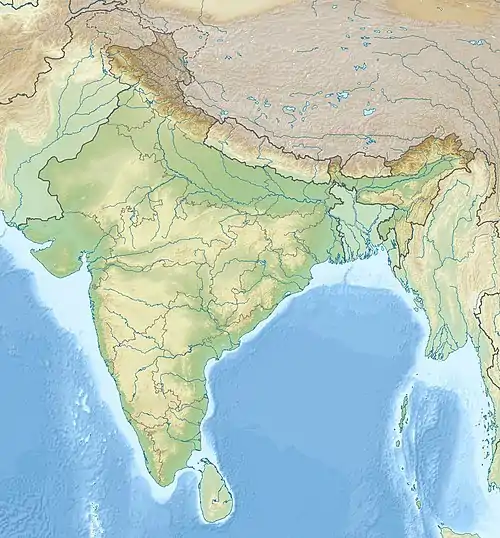Aulikara Empire
The Aulikara Empire was a short-lived power founded by Yashodharman of Malwa, who belonged to the Aulikara dynasty. It was centred around the Malwa plateau, bordered by the Brahmaputra River and the Indian Ocean in the east and west, and the Himalayas and Mahendra mountains to the north and south.[1][2] The Aulikara Empire was ruled by the Second Aulikara dynasty.
Establishment
Aulikara rulers such as Adityavardhana and Dravyavardhana expanded their kingdom[5] and one of their successors Yashodharman conquered vast territories from the Hunas and Guptas after the Battle of Sondani, defeating the Huna Chief Mihirakula around 528 A.D.[6][7][8][9], thus establishing the short-lived Aulikara empire.[10][11][12] Yashodharman's capitol was almost certainly Dashapura,[13][14][15][16] probably established by Yashodharman[17] though initially thought to have been Ujjayinī, which has since been disproven.[15] Kingdoms such as the Later Guptas and Maukhari dynasty were their vassals.[18]
Decline
Most of the empire disintegrated after Yashodharman's death.[19] Nothing is known about the dynasty after his death, and Malwa was conquered by the Kalachuris of Mahishmati.[20][21]
After the collapse of Aulikara power in Northern India, the Later Guptas and Maukharis began fighting for imperial supremacy.[18]
See also
References
- Ojha, N.K. (2001). The Aulikaras of Central India: History and Inscriptions, Chandigarh: Arun Publishing House, ISBN 81-85212-78-3, pp.19-20
- J. L. Jain (1994). Development and Structure of an Urban System. Mittal Publications. p. 30. ISBN 978-81-7099-552-4.
- Salomon, Richard (1989). "New Inscriptional Evidence For The History Of The Aulikaras of Mandasor". Indo-Iranian Journal. 32 (1): 11. doi:10.1163/000000089790082971. ISSN 0019-7246. JSTOR 24654606.
- Corpus Inscriptionum Indicarum Vol 3 p.145
- Jain, Kailash Chand (31 December 1972). Malwa Through The Ages. Motilal Banarsidass Publ. ISBN 978-81-208-0824-9.
- Singh, Pradeep. "YASHODHARMAN ~ यशोधर्मा,King of Malwa kept Malichha(Non Hindus), on defensive for 600 years". Retrieved 2022-06-29.
- "Studies in Ancient Indian History" (PDF). sahitya.marathi.gov.
- Fleet, John Faithfull (1960). Inscriptions Of The Early Gupta Kings And Their Successors.
- Fleet, John Faithful (1981). Corpus Inscriptionum Indicarum Vol.3 (inscriptions Of The Early Gupta Kings).
- Tribal Culture, Faith, History And Literature, Narayan Singh Rao, Mittal Publications, 2006 p.18
- Corpus Inscriptionum Indicarum Vol 3 p.145
- Foreign Influence on Ancient India by Krishna Chandra Sagar p.216
- Dwivedi, Gautam N. (1966). "The Date and Identity of Yasodharman-Visnuvardhana". Proceedings of the Indian History Congress. 28: 45–50. ISSN 2249-1937. JSTOR 44140389.
- Atherton, Cynthia Packert (1997). The Sculpture of Early Medieval Rajasthan. BRILL. ISBN 978-90-04-10789-2.
- Balogh, Dániel (2019-10-28). Inscriptions of the Aulikaras and Their Associates. Walter de Gruyter GmbH & Co KG. ISBN 978-3-11-064978-9.
- Bakker, Hans T. (2020-03-31). The Alkhan: A Hunnic People in South Asia. Barkhuis. ISBN 978-94-93194-06-9.
- Atherton, Cynthia Packert (1997). The Sculpture of Early Medieval Rajasthan. BRILL. ISBN 978-90-04-10789-2.
- Shastri, Ajay Mitra (1991). Varāhamihira and His Times. Kusumanjali Book World.
- Sagar, Krishna Chandra (1992). Foreign Influence on Ancient India. Northern Book Centre. ISBN 978-81-7211-028-4.
- Early History of Rajasthan. Bharatiya Vidya Prakashan. 1978.
- Shastri, Ajay Mitra (1991). Varāhamihira and His Times. Kusumanjali Book World.

.svg.png.webp)